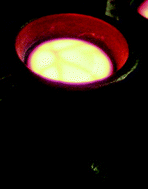This paper discusses the potential of laser ablation-inductively coupled plasma mass spectrometry (LA-ICPMS) for the determination of Au, Ir, Pd, Pt, Rh and Ru in NiS buttons obtained by fire assay of platiniferous ores. The method finally proposed is based on: (i) the sampling of large amounts of ores (40–75 g) in order to compensate for the typical inhomogeneous distribution of the target elements over the sample matrix; (ii) the grinding of the NiS buttons obtained after the fire assay procedure in order to obtain more homogeneous samples and the subsequent pelleting of the resulting powders using polyethylene wax as a binder; (iii) LA-ICPMS analysis based on the use of the line profiling mode for ablation of a representative portion of sample during each replicate measurement; (iv) the pressurization of the dynamic reaction cell (DRC) with ammonia in order to cope with all spectral interferences, and the optimization of the RPq setting to prevent the clustering of ammonia with the main matrix components (Ni, Cu), which could otherwise give rise to new spectral overlaps; and (v) the use of home-made matrix-matched standards for calibration, combined with the monitoring of 61Ni as an internal reference. In this way, it was feasible to obtain accurate values for all of the samples investigated with RSD values typically below 10% and LODs at the 10 ng g−1 level. This performance makes the method appealing for the control of these types of samples in the platinum group metal industry, successfully circumventing the need for the cumbersome digestion procedures currently in use.

You have access to this article
 Please wait while we load your content...
Something went wrong. Try again?
Please wait while we load your content...
Something went wrong. Try again?


 Please wait while we load your content...
Please wait while we load your content...